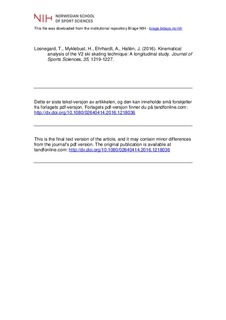| dc.contributor.author | Losnegard, Thomas | |
| dc.contributor.author | Myklebust, Håvard | |
| dc.contributor.author | Ehrhardt, Angela | |
| dc.contributor.author | Hallén, Jostein | |
| dc.date.accessioned | 2018-04-30T11:31:55Z | |
| dc.date.available | 2018-04-30T11:31:55Z | |
| dc.date.created | 2017-01-12T12:57:39Z | |
| dc.date.issued | 2017 | |
| dc.identifier.citation | Journal of Sports Sciences. 2017, 35, 1219-1227. | nb_NO |
| dc.identifier.issn | 0264-0414 | |
| dc.identifier.uri | http://hdl.handle.net/11250/2496533 | |
| dc.description | I Brage finner du siste tekst-versjon av artikkelen, og den kan inneholde ubetydelige forskjeller fra forlagets pdf-versjon. Forlagets pdf-versjon finner du på tandfonline.com / In Brage you'll find the final text version of the article, and it may contain insignificant differences from the journal's pdf version. The definitive version is available at tandfonline.com | nb_NO |
| dc.description.abstract | To characterise timing of movements and evaluate performance effects of technique alterations in V2 ski skating, 13 elite male cross-country skiers (age, 23 ± 2 years; stature, 182 ± 6 cm; body mass, 76 ± 8 kg; V2 V̇O2max, 79.3 ± 4.4 mL · kg−1 · min−1) were tested four times during the preparation and competition phase on a roller ski treadmill. Each test consisted of submaximal intensities of exercise for determination of oxygen cost followed by one 1000-m performance test. Hip movement (from accelerometer data) and joint angles (2D video) were determined for high-intensity exercise (6° and 3.5 m · s−1; ~ 97–100% of V̇O2peak). Each ski thrust consisted of three phases: gliding phase (18–50% of cycle time), poling phase (50–70% of cycle time), and kick phase (70–78% of cycle time). Flexion/extension of the hip initiated all phases, followed by the respective joints in legs and arms. Mixed-model analysis, adjusting for systematic time-point effects, identified that both reduced vertical hip acceleration and increased cycle time gave a small likely reduction in oxygen cost and 1000-m time. In conclusion, well-developed hip movement is a key characteristic of the V2 technique for elite-standard skiers’ long-term performance development. | nb_NO |
| dc.language.iso | eng | nb_NO |
| dc.subject | accelerometer | nb_NO |
| dc.subject | cross-country skiing | nb_NO |
| dc.subject | elite | nb_NO |
| dc.subject | mixed model | nb_NO |
| dc.subject | oxygen cost | nb_NO |
| dc.subject | performance | nb_NO |
| dc.title | Kinematical analysis of the V2 ski skating technique: A longitudinal study | nb_NO |
| dc.type | Journal article | nb_NO |
| dc.type | Peer reviewed | nb_NO |
| dc.description.version | acceptedVersion | nb_NO |
| dc.source.pagenumber | 1219-1227 | nb_NO |
| dc.source.volume | 35 | nb_NO |
| dc.source.journal | Journal of Sports Sciences | nb_NO |
| dc.source.issue | 12 | nb_NO |
| dc.identifier.doi | 10.1080/02640414.2016.1218036 | |
| dc.identifier.cristin | 1425819 | |
| dc.description.localcode | Seksjon for fysisk prestasjonsevne / Department of Physical Performance | nb_NO |
| cristin.unitcode | 150,31,0,0 | |
| cristin.unitname | Seksjon for fysisk prestasjonsevne | |
| cristin.ispublished | true | |
| cristin.fulltext | postprint | |
| cristin.qualitycode | 1 | |
